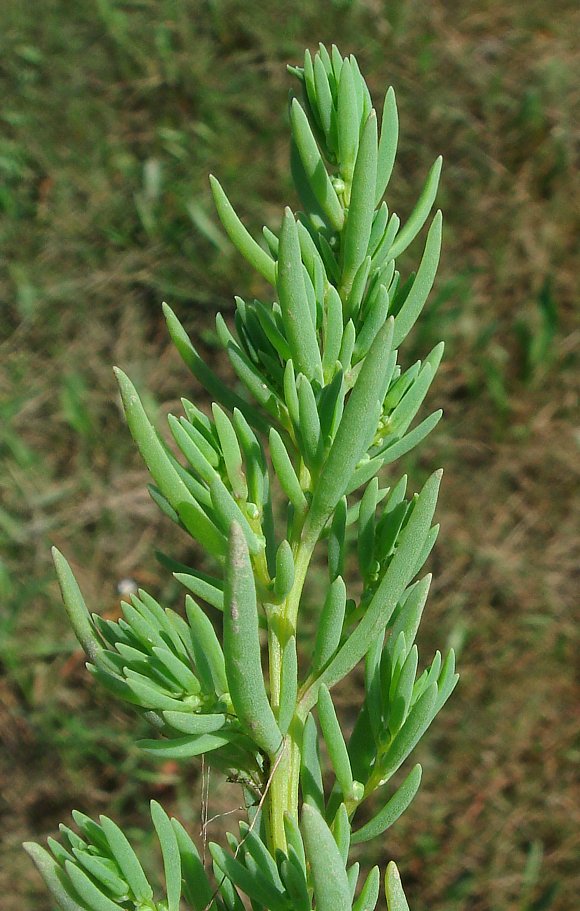If you could choose one wild plant to become a commercial product, what would it be?
 Many people have tried to make poke weed (Phytolacca americana) a green in your local grocery but toxicity and the required two-boilings have always plagued its commercialization. The ground nut (Apios americana) was one of the original exports from colonial America but it has at least a two-year growth cycle. Louisiana State University (1984-96) developed a commercial variety but the program disappeared when the professor-in-charge, Bill Blackmon, changed colleges. In 1962 Professor Julia Morton of the University of Miami recommended Spanish Needles (Bidens pilosa) become a commercial product. A half a century later that hasn’t happened, perhaps because of flavor or the fact it can grow almost anywhere as a weed. My candidate would be Suaeda linearis, Seablite, and if I could figure out how to do it I would.
Many people have tried to make poke weed (Phytolacca americana) a green in your local grocery but toxicity and the required two-boilings have always plagued its commercialization. The ground nut (Apios americana) was one of the original exports from colonial America but it has at least a two-year growth cycle. Louisiana State University (1984-96) developed a commercial variety but the program disappeared when the professor-in-charge, Bill Blackmon, changed colleges. In 1962 Professor Julia Morton of the University of Miami recommended Spanish Needles (Bidens pilosa) become a commercial product. A half a century later that hasn’t happened, perhaps because of flavor or the fact it can grow almost anywhere as a weed. My candidate would be Suaeda linearis, Seablite, and if I could figure out how to do it I would.
Seablite has everything going for it except perhaps for its name. It’s mild but tasty, has excellent texture, can be eaten raw or cooked though cooked is the usual way. It’s nutritious, stores well, looks good, easily grows in salty ground (read unused land) and even feels good to handle. About the only downside, for me, is that I have to drive about 60 miles to get some. I need to introduce it to my garden.
Think of Seablite as a Chinopodium that likes to grow in salty places, either near the ocean or salt licks. It has a high sodium content but boiling reduces that significantly. If you live anywhere near the ocean or inland salty areas, now and the next few months is the time to go looking for seablite and seepweeds.


I hear you, Sea Blight is darn tasty. I would vote for the Doca / Tasi / Latexplant, Morrenia odorata… I love those cooked fruits. I also cast a vote for Lambsquarters, and I’m surprised that you rarely see it for sale, although I see it pop up at the Ithaca, New York farmer’s market each spring. I also have seen named varieties at a couple of organic farms. I am fortunate to find large amounts of lambsquarters in my area of Arcadia, Florida each spring, around the edge of some active sand quarries.
Hmmm… Both of them are vegetables sold elsewhere now. I haven’t heard of seablight being sold now. It used to be in England and the like. By the way I will be heading down your way the end of the month.
Interesting subject. I’m very new to wild foods (about a year now), but have done much research, and have found edibles around my home, families properties, and at work (golf course).
As one knows, researching wild edibles, permaculture, and home gardening, you uncover lots of other information. Some of which is vegetables that have been bread for looks and/or size, and in the process, nutrient content suffers. Or these giant companies playing God and genetically modifying the plants DNA.
So, it’s anyone’s choice what they would like to see brought to the market, but it’s my fear what would come of it, when dollars and cents gets brought into the mix, ya know, in the name of making as much money as possible, as for breading a more profitable product.
Some of the GMO’s have a tendency to contaminate the wild, or non GMO species, and that scares me a lot. I wonder if preserving these wild species may be a better way of dealing with things. Perhaps keeping these god given wild edibles (which are better and more healthy for us) safe from the evils of business.
My project ongoing now, is starting a permaculture towards winter’s end, and utilizing the wild edibles I want. Dandelions will be high on my list, but I have much more research to do, and lots of things to get done and planned out. I hear they are already selling dandelion greens in some supermarkets. And if so, you must assume selective breading must have already be underway. Who knows what’ll be next.
While talking with my doctor, he always has a little laugh when I bring up wild edibles, but he admits, how do we know the organic food we buy is really organic? We agreed, that raising your own food, both plant and livestock, is truly the only real way to know what you’re eating. And more and more, this is what I want to do more than anything.
So, in light of what I believe, I don’t want to see any wild edible brought to market, in fear of what may come of it.
Anyway, don’t shout at me Green, this extra long post is just a passing thought. I’m just leaning more towards preserving these great wild edibles.
I know this is an old thread, but my vote is Dandelion! Maybe if it was available in markets people would lose their disdain toward it. 🙂